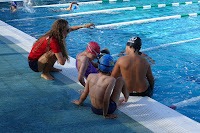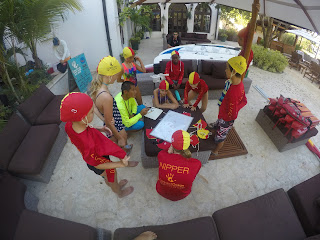As the
first step on our way to becoming a divemaster, the two of us had to complete
our PADI Rescue Diver Training. We built, together with three other
enthusiastic divers, a training group of 5 divers.
Our
training started with an Emergency First Response course (EFR). We had the
possibility to do the course together with the crew from Marlin del Rey on their catamaran. What a nice classroom.
In
two days, we learned a lot about the first response, first aid, and CPR. We trained
different skills to handle Emergency situations and learned how important it is
to act fast but safe and that we must handle a situation out of our comfort
zone. Able
care given is better than perfect care withheld. It was two intense days with a
lot of information. But it was good training and now we all feel more
comfortable to respond if we encounter an emergency.
In
two pool sessions, we trained the practical skills to rescue a diver in
different critical situations. We learned how to handle a panicked diver or a tired diver on
the surface. We trained different skills as well for an unconscious diver on
the surface or during a dive. The different exercises were intense, but it was
necessary. Time is here also very important! It is necessary to act on a plan.
And that’s only possible with proper training.
Next thing we did was to go out in the ocean to practice different search patterns. And this training was
like a real situation. The visibility was really bad, like 20 cm (8 inches). It
was really difficult to find the missing object. But we were able to train our
navigation skills and learn that we must trust our compass. Any kind visual
orientation was impossible. But it is in exactly in these kinds of conditions that it's more likely a diver goes missing.
We
repeated the navigation pattern workshop on another day on a different dive site.
The visibility was much better and all of us completed the exercise
successfully. On this point, we were ready for the final scenario, the missing diver scenario. Our dive instructors
and divemaster set up a scenario for us and we as a team of 5 rescue divers were to handle the emergency. The scenario started, and we ignored the first
rule of Emergency First Respond. Stop-think-act. All of us started to act and
it ended up in chaos. We were just able to rescue all the divers with help from
the instructor. At the debriefing, we spoke about all our mistakes and what we
did right. Then, out of stress, we realized how we could have handled the situation better. The result of our final scenario was clear. We failed. But we
learned a lot in this scenario. So maybe it was good to fail first because now we know how not to act. We get a second chance to pass our final scenario on
another day.
We, Anna
and Matthias, got another chance one week later, We were on a dive with other students
and during the surface interval our instructors started a new rescue scenario.
We were not prepared for this scenario at all and but remembered to stop, think and act. Anna took the lead and
together we were able to rescue the panicked diver and interview him for his
missing friend. We asked the captain if he can look for bubbles on the surface
and he finally found them. Together with the information from the interview and
the observation from the captain we could find the missing diver. We were
able to rescue the diver and started with emergency first response, like CPR
and rescue breaths. This time we acted really good as a team. We passed the final scenario and we are know official
rescue diver.
Happy
Day


















































